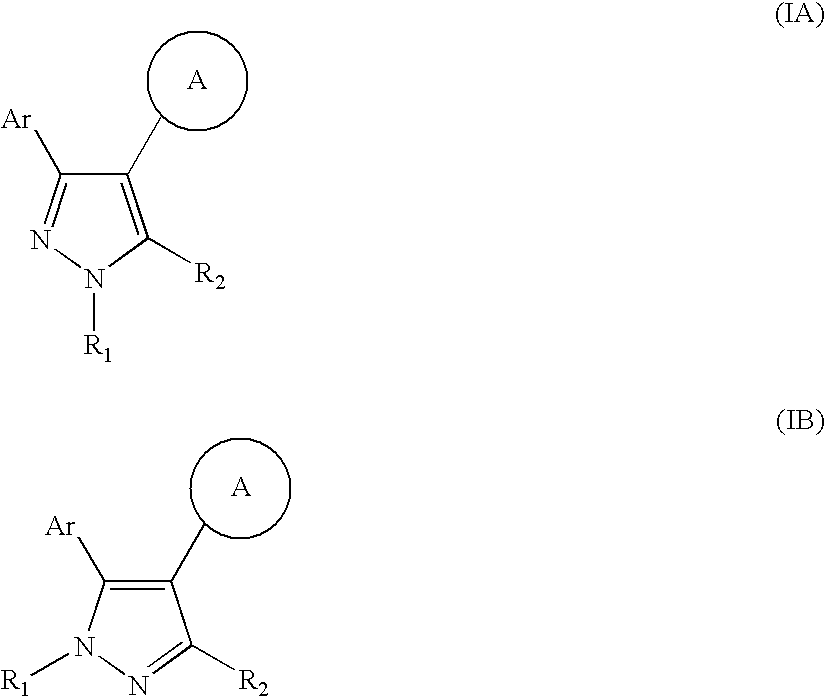Pyrazole compounds
a technology of pyrazole and compounds, which is applied in the field of pyrazole compounds, can solve the problems of radicicol lacking antitumour activity in vivo, deregulation of molecular and physiological functions in the cell, and degradation of a number of hsp90-chaperoned signalling proteins, so as to inhibit the proliferation of cancer cells
- Summary
- Abstract
- Description
- Claims
- Application Information
AI Technical Summary
Benefits of technology
Problems solved by technology
Method used
Image
Examples
example 1
4-[3-(5-Chloro-2,4-dihydroxy-phenyl)-1H-pyrazol-4-yl]-piperazine-1-carboxylic acid tert-butyl ester, and
example 2
4Chloro-6-(4-piperazin-1-yl-1H-pyrazol-3-yl)-benzene-1,3-diol
[0088]
[0089]
[0090]Step 1
1-(5-Chloro-2,4-dihydroxy-phenyl)-ethanone
[0091]
[0092]Acetic acid (17.5 mL) was added dropwise to a suspension of 4-chlororesorcinol (42.5 g, 0.293 mmol) in boron trifluoride etherate (200 mL) under a nitrogen atmosphere. The reaction mixture was heated at 90° C. for 3.5 hours and then allowed to cool to room temperature. A solid had formed after around 1 hour of cooling. The mixture was poured into 700 mL of a 10% w / v aqueous sodium acetate solution. This mixture was stirred vigorously for 2.5 hours. A light brown solid had formed which was filtered, washed with water and air-dried overnight to afford 1-(5-chloro-2,4-dihydroxy-phenyl)-ethanone (31.6 g, 58%). LCMS: [M−H]+ 185.
[0093]Step 2
1-(2,4-Bis-benzyloxy-5-chloro-phenyl)-ethanone
[0094]
[0095]Benzyl bromide (30 mL) was added to a mixture of 1-(5-chloro-2,4-dihydroxy-phenyl)-ethanone (20 g, 0.107 moles) and potassium carbonate (37 g, 2.5 equiv) in ...
example 5
4-Chloro-6-[4-(4-furan-2-ylmethyl-piperazin-1-yl)-1H-pyrazol-3-yl]-benzene-1,3-diol
[0121]
this compound was made by the route summarised in Scheme 2:
[0122]
[0123]Sodium triacetoxyborohydride (150 mg, 0.7 mmol) was added in one portion to a mixture of 4-chloro-6-(4-piperazin-1-yl-1H-pyrazol-3-yl)-benzene-1,3-diol (43 mg, 0.146 mmol), furfuraldehyde (0.025 ml, 0.3 mmol), acetic acid (0.5 ml) and dichloromethane (1 ml). Stirring under nitrogen was continued for 3 h, and the reaction mixture was partitioned between water (10 ml) and dichloromethane (3×10 ml). The combined organic phases were dried over magnesium sulphate and concentrated and purified on a bond elute cartridge (5 g) eluting with dichloromethane:ethanol:ammonia (100:8:1) gave 4-chloro-6-[(4-(4-furan-2-ylmethyl-piperazin-1-yl)-1H-pyrazol-3-yl]-benzene-1,3-diol as a white solid (10 mg).
[0124]LC retention time 1.68 minutes [M+H]+ 375.3 (Run time 3.75 min)
[0125]The compound of Example 5 had activity ‘B’ in the ATPase assay desc...
PUM
| Property | Measurement | Unit |
|---|---|---|
| temperature | aaaaa | aaaaa |
| temperature | aaaaa | aaaaa |
| temperature | aaaaa | aaaaa |
Abstract
Description
Claims
Application Information
 Login to View More
Login to View More - R&D
- Intellectual Property
- Life Sciences
- Materials
- Tech Scout
- Unparalleled Data Quality
- Higher Quality Content
- 60% Fewer Hallucinations
Browse by: Latest US Patents, China's latest patents, Technical Efficacy Thesaurus, Application Domain, Technology Topic, Popular Technical Reports.
© 2025 PatSnap. All rights reserved.Legal|Privacy policy|Modern Slavery Act Transparency Statement|Sitemap|About US| Contact US: help@patsnap.com



